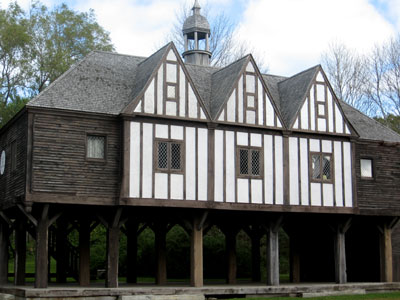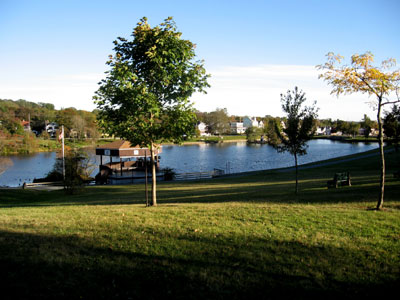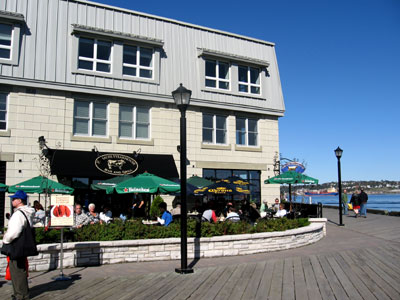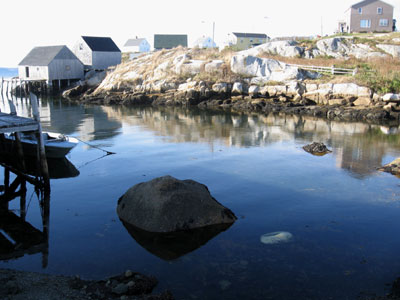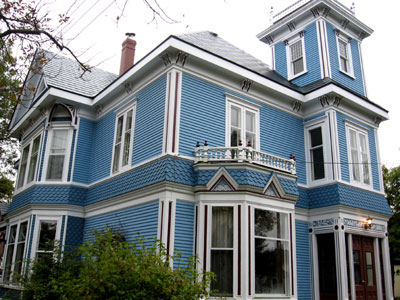My quick one-night stopover in Yarmouth had provided me with great insight into local history and architecture. In an interview with two local hospitality entrepreneurs I also learned about the heritage tourism opportunities in southwestern Nova Scotia. Barely an hour into the drive I unintentionally orchestrated my own travel adventure by actually driving into the ditch and a few local residents immediately rescued me from my predicament.
After all this excitement I was back on the road and enjoying my drive eastwards. The weather improved from a cool drizzle to overcast skies, and it was looking like I might even get some blue skies later today. The Lighthouse Trail hugs the southern Nova Scotia shoreline while Highway 103 pursues a straighter trajectory inland. In order to make it on time to my stop in Shelburne and to today’s final destination of Lunenburg, I followed the inland route with the occasional side-trip to the waterfront.

Ste-Anne, the oldest parish in Nova Scotia, dating back to 1799
Straight south from Yarmouth is a peninsula with a town called Wedeport at the end. This is the location of la Butte-de-la-Croix, a site that commemorates the first mass after the return of the Acadians, held in 1769. Acadians were expelled in several waves by the English between 1755 and 1763 and deported to numerous destinations across eastern North America, the Caribbean and even back to France during an extended period of ethnic cleansing. Some of the French Acadian settlers returned to Nova Scotia, and the Wedgeport location in particular is a symbol of Acadian courage and perseverance.
East of Wedgeport are the Tusket Islands, about 365 islands, peninsulas, inlets and bays that make up an intended coastline. The Bay of Fundy’s tides have a big impact on this area, and salt water travels 24 km kilometers (15 miles) upriver on tides that are about 4 metres (13 feet high). The islands vary in size from a few meters to half a kilometer in length. This area was first settled by Acadian French settlers and to this day French dialects and customs survive in this area. Today there are thousands of “shanties”, small tiny cottages, while in the past this area also featured large fish factories and lobster canneries. Sea kayakers looking for bird-watching and island hopping opportunities love this area.

Driving along Highway 103
The Pubnico region comprises three different sections: West Pubnico, with an almost exclusively French-speaking population, Pubnico proper with primarily Anglophone residents, and East Pubnico, again occupied mostly by French speakers. French Acadian settlements go back to about 1614. Today, the local population mostly makes a living from the fishing industry, which includes first and foremost lobster, scallops, herring, haddock and cod. Not only is Pubnico considered to be the oldest village which, in Acadia, is still occupied by the Acadians, but it is also the oldest village in Canada still occupied by the descendants of its founder. Since February of 2005 renewable energy is being produced at Pubnico Point. 17 interconnected wind turbines generate about 100 GWh a year.
Further east along the shoreline is Cape Sable Island, the most southerly point in Atlantic Canada. This small, low sandy island is the location of about 1800 recorded shipwrecks since 1676. It took until 1861 for the first light house to be constructed on Sable Island, and in 1876 a steam-whistle fog alarm was added. Even since then ships continue to run aground in this foggy, harsh marine environment, but the loss of life has been low.

Saint Matthews United Church
The next major town along Highway 103 is Barrington which also claims to be the Lobster Capital of Canada. The area around Barrington features a variety of fishing villages, museums and heritage buildings. Not far outside Barrington a major mystery awaits: just southwest of the town is the Shag Harbour UFO sighting area, location of a purported UFO crash on October 4, 1967. At least eleven people reported seeing a low-flying lit object heading towards the harbour, accompanied by a whistling and then a crashing sound when the object hit the water. A search and rescue operation did not turn up any evidence of a crash, and no aircraft were reported missing. A secretive military expedition discovered some foam-like debris, and one military witness stated that there were actually two objects, one possibly trying to assist the other. To this day the Shah Harbour UFO Crash is an unsolved mystery.

The tourist office right next to Shelburne’s waterfront
The town of Barrington itself features a recently constructed walking trail along the bay. The Barrington Woolen Mill, dating back to 1882, was an active mill until 1962 when it ceased production and became a museum in 1968. Wool sheared from sheep who were grazed on the various surrounding islands were processed in this turbine-driven mill that saved Nova Scotian women endless time in terms of washing, spinning and weaving wool at home.

Shelburne’s Post Office and Customs House
